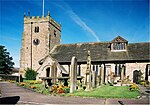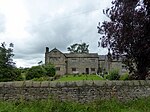Kirk Mill

Kirk Mill is an early example of an Arkwright-type cotton mill and a grade II listed building in Chipping, Lancashire, in Ribble Valley, to the north of Preston, Lancashire, England. It was built in the 1780s on the site of a corn mill dating from at least 1544. The mill continued spinning cotton using water frames and then throstles until 1886, when it was sold and became HJ Berry's chairmaking factory. It was powered by a 32 ft (9.8 m) waterwheel which continued in use, generating electricity until the 1940s. Chipping really thrived during the Industrial Revolution when there were seven mills located along Chipping Brook. The last survivor was Kirk Mill, the chair making factory of HJ Berry, but in 2010 the company went into administration, the factory closed, and on 7 March 2011 the works were bought by SCPi Bowland LtdSignificant refurbishment works including a full re-roof, stone cleaning, re-pointing with lime mortar, removal of incongruous late additions and the introduction of structural steelwork were completed in spring 2017
Excerpt from the Wikipedia article Kirk Mill (License: CC BY-SA 3.0, Authors, Images).Kirk Mill
Church Raike, Ribble Valley Chipping
Geographical coordinates (GPS) Address Nearby Places Show on map
Geographical coordinates (GPS)
| Latitude | Longitude |
|---|---|
| N 53.8868 ° | E -2.5785 ° |
Address
Church Raike
Church Raike
PR3 2QL Ribble Valley, Chipping
England, United Kingdom
Open on Google Maps





